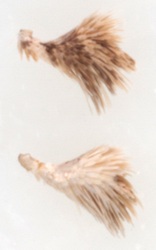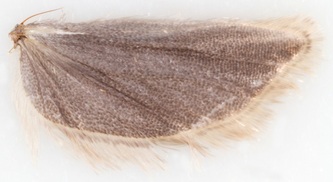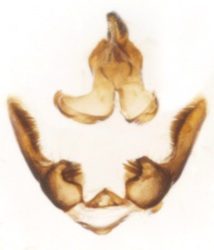49.194 Bactra lancealana (Common Lance)
ws: 11-20mm; bivoltine May-Jul, Jul-Oct; bog rush (Juncus subuliflorus), common club-rush (Schoenoplectus lacustris), deergrass (Scirpus cespitosum); common throughout GB
ID: Very variable. The prominent disco-cellular marking (which represents its obsolescent median fascia), when present will distinguish this species from B.furfurana and B.robustana but not from B.lacteana. Sterling and Parsons suggest that in B.lacteana there are two long narrow parallel black lines in the median longitudinal streak between the disco-cellular crescent mark and the apex, and that B.lancealana does not show these lines.
Male genitalia: In B.furfurana and B.lacteana the saccular spines do not cross the edge of the sacculus. In B.lancealana and B.robustana the saccular spines are large, blade-like and they protrude beyond the saccular margin. B.lancealana has 2-7 spines and the margin of the sacculus between the spines and the sacculo-valvar junction is angular; B.robustana has 3-4 spines and the saccular margin is more rounded, though still somewhat angular. The saccular spines of B.robustana are longer and stouter than those of B.lancealana. In both B.lancealana and B.robustana there is a separate patch of 1 or 2 saccular spines near the sacculo-valvar junction. The degree of angulation of the sacculus of B.lancealana seems to be variable and interpretation of it is also dependent to some extent on the angle of view/preparation (see images below) - it may be that some specimens taken in saltmarsh habitat, that lack a discocellular mark and possess 3-4 saccular spines cannot be reliably identified to species.
Male genitalia: In B.furfurana and B.lacteana the saccular spines do not cross the edge of the sacculus. In B.lancealana and B.robustana the saccular spines are large, blade-like and they protrude beyond the saccular margin. B.lancealana has 2-7 spines and the margin of the sacculus between the spines and the sacculo-valvar junction is angular; B.robustana has 3-4 spines and the saccular margin is more rounded, though still somewhat angular. The saccular spines of B.robustana are longer and stouter than those of B.lancealana. In both B.lancealana and B.robustana there is a separate patch of 1 or 2 saccular spines near the sacculo-valvar junction. The degree of angulation of the sacculus of B.lancealana seems to be variable and interpretation of it is also dependent to some extent on the angle of view/preparation (see images below) - it may be that some specimens taken in saltmarsh habitat, that lack a discocellular mark and possess 3-4 saccular spines cannot be reliably identified to species.
|
§1 Sutton Fen, Norfolk; 05/06/2009; male
§2 Foulness, Essex; 08/08/2010; male; fw 8.4mm §3 Newgale, Pembrokeshire; 19/05/2011; male; fw 8.2mm §4 Removed §5 Mull; 25/06/2011; male; fw 8.8mm §6 Glen Strathfarrer, Inverness-shire; 19/07/2012; male §7 Foulness, Essex; 30/06/2013; male; fw 8.8mm §8 Foulness, Essex; 30/06/2013; male; fw 9.3mm §9 Fersit, Argyll; 28/07/2013; female All images © Chris Lewis |
§10 New Forest, Hampshire; 22/06/2016; female; fw 6.7mm
§11 Seathwaite, Cumbria; 25/07/2016; male; fw 7.3mm; to light §12 Bampton Grange, Cumbria; 05/07/2017; female; fw 6.6mm §13 Bampton Grange, Cumbria; 11/07/2017; male; fw 6.6mm §14 Ben Lawers, Perthshire; 24/06/2018; male; 6.6mm §15 Stour Wood, Essex; 06/06/2021; male; fw 8.4mm §16 Kintail, West Ross & Cromarty; 26/07/2023; female; fw 7.1mm §17 Eskmeals dunes, Cumbria; 21/06/2023; male; fw 9.3mm |
Page published 09/01/2013 (§1-6) | §7&8 added and text amended 03/11/2013 | §9 added 27/03/2013 | §10 added 21/05/2017 |
§11 added 28/06/2017 | text amended 30/10/2017 | §12&13 added 11/04/2018 §14 added ?/12/18; §15 added 28/11/2021 |
§16 added 10/12/2023 | §17 added 18/12/2023
§11 added 28/06/2017 | text amended 30/10/2017 | §12&13 added 11/04/2018 §14 added ?/12/18; §15 added 28/11/2021 |
§16 added 10/12/2023 | §17 added 18/12/2023







































